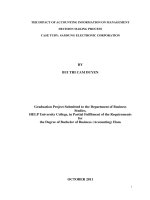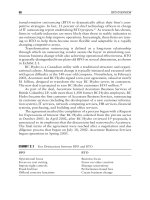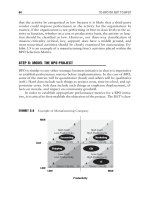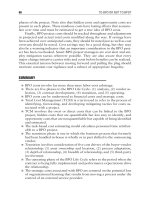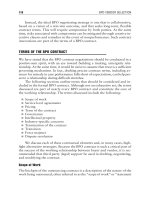Interface conflicts and regulatory decision making process on power projects in sri lanka
Bạn đang xem bản rút gọn của tài liệu. Xem và tải ngay bản đầy đủ của tài liệu tại đây (1.22 MB, 295 trang )
INTERFACE CONFLICTS AND REGULATORY DECISION
MAKING PROCESS ON POWER PROJECTS IN SRI LANKA
LAWRENCE LESLY EKANAYAKE
[M.Sc. (Building) (NUS), B.Sc. (Eng.) (Moratuwa)]
A THESIS SUBMITTED
FOR THE DEGREE OF DOCTOR OF PHILOSOPHY
DEPARTMENT OF BUILDING
SCHOOL OF DESIGN AND ENVIRONMENT
NATIONAL UNIVERSITY OF SINGAPORE
2005
i
ACKNOWLEDGEMENTS
I wish to express my heartfelt gratitude to my supervisor, Professor George Ofori, who
was the main inspiration behind my work. I am so grateful to him for his guidance and
encouragement throughout my research. His care and concern for my personal well-being
and progress during this research will continue to be remembered with gratitude.
Furthermore, I wish to thank Associate Professor Willie Tan, a member of my
thesis committee, for providing exceptionally important comments, directions, methods,
and necessary guidance throughout my research. I am so grateful to him for his advice
that helped me to complete my thesis.
I would also like to thank both academic and non-academic members of the
Department of Building, National University of Singapore (NUS), for their support and
help in various forms. My gratitude also goes to NUS for granting me a research
scholarship, without which this thesis would not have been a reality.
My gratitude goes to all the participants who responded to the questionnaire
survey and interviews. I express special thanks to Gamini Silva, B.A Perera, Leonard,
Akram, and Lakshan for assisting me during the questionnaire survey in Sri Lanka.
Special thanks also go to Afful, Janaka, Koh, Malitha, OG, Sudesh, and Suranga for
reading the first draft of my thesis and giving suggestions. Further, it is a pleasure to
remember my colleagues in the Department and NUS; I can never forget all my friends
who supported me during my stay in NUS and made the time joyful.
My warmest thanks go to my wife for all the encouragement, care, and love that
made the completion of my research possible. I love my son and wife who made me
laugh along the way. I am grateful to my parents, brothers and sisters for their unlimited
love. I love you all.
ii
To my parents, wife and son with love
iii
TABLE OF CONTENTS
Acknowledgements i
Table of contents iii
Summary xiii
List of tables xv
List of figures xvii
List of abbreviations xxi
CHAPTER 1 INTRODUCTION 1
1.1 BACKGROUND 1
1.2 RESEARCH PROBLEM 1
1.3 RESEARCH HYPOTHESIS 5
1.4 RESEARCH JUSTIFICATION 5
1.5 RESEARCH OBJECTIVES 7
1.6 RESEARCH METHODOLOGY 7
1.7 RESEARCH SCOPE 9
1.8 OUTLINE OF THE THESIS 10
CHAPTER 2 INTERFACE CONFLICTS IN CONSTRUCTION
PROJECTS
13
2.1 INTRODUCTION 13
2.2 INTERFACE CONFLICTS IN LARGE-SCALE
PROJECTS
13
2.3 ECONOMIC VERSUS ENVIRONMENTAL
CONSIDERATIONS
16
2.3.1 Win-lose negotiation 17
2.3.2 Win-win negotiation 17
2.3.3 Mixed-motive negotiation 18
2.4 COGNITIVE BARRIERS 19
2.4.1 The mythical fixed-pie 19
2.4.2 Sacredness effects 20
iv
2.4.3 Endowment effects 20
2.4.4 Overconfidence effects 21
2.4.5 Positive illusions effects 21
2.4.6 Egocentrism effects 22
2.5 SOCIO-PSYCHOLOGICAL BARRIERS 23
2.5.1 Understanding the facts of a conflict 23
2.5.2 Understanding the interests of other parties 24
2.5.3 Understanding the fairness concerns 24
2.6 INSTITUTIONAL RESPONSE 25
2.7 ROLE OF INFORMATION IN ENVIRONMENTAL
VERSUS ECONOMIC CONFLICTS
27
2.8 RESOLVING ECONOMIC VERSUS
ENVIRONMENTAL CONFLICTS
28
2.8.1 Procedural fairness 28
2.8.2 Alternative dispute resolution approach 29
2.8.3 Environmental impact assessment approach 30
2.9 SUMMARY 31
CHAPTER 3 ENVIRONMENTAL IMPACT ASSESSMENT 32
3.1 INTRODUCTION 32
3.2 MANAGING THE EIA PROCESS 32
3.2.1 Managing EIA screening and scoping 32
3.2.2 Managing impact prediction, evaluation and
reporting
35
3.2.3 Managing public participation and decision making 39
3.2.4 Managing EIA monitoring and auditing 41
3.3 DEFICIENCIES IN EIA PROCESS 42
3.4 KNOWLEDGE GAP 44
3.5 SUMMARY 45
v
CHAPTER 4 THE SRI LANKAN EIA PROCESS 46
4.1 INTRODUCTION 46
4.2 BACKGROUND OF SRI LANKA 46
4.3 INTRODUCING AND IMPLEMENTING
ENVIRONMENTAL LEGISLATION
47
4.4 THE EIA MODEL IN SRI LANKA 50
4.5 THE EIA IMPLEMENTATION IN SRI LANKA 53
4.6 DRAWBACKS OF THE EIA MODEL AND PRACTICES 55
4.7 KNOWLEDGE GAP AND HYPOTHESIS 58
4.8 POSSIBLE AMENDMENTS TO THE EIA MODEL 60
4.9 INSTITUTIONAL CHANGES REQUIRED TO
IMPLEMENT PROPOSED EIA MODEL
62
4.10 SUMMARY 63
CHAPTER 5 RESEARCH METHODOLOGY 65
5.1 INTRODUCTION 65
5.2 RESEARCH DESIGN 65
5.3 PILOT STUDY 66
5.4 VALIDATION OF CONSENSUS-BUILDING
AMENDMENTS ON THE PROPOSED EIA MODEL
69
5.4.1 The basis of Analytical Hierarchy Process (AHP) 71
5.4.2 Expert Choice (EC-11) software for group decision-
making
72
5.4.3 The identification of the stakeholders for the model
validation
73
5.5 METHODS OF DATA COLLECTION 76
5.5.1 Model for consensus-building on EIA dispute 78
5.5.2 Questionnaire design 81
5.6 DATA PROCESSING 84
5.7 SUMMARY 85
vi
CHAPTER 6 DISCUSSION ON THE PILOT STUDY 86
6.1 INTRODUCTION 86
6.2 UPPER KOTMALE HYDROPOWER PROJECT (UKHP) 86
6.2.1 Opposing groups - (UKHP) 89
6.2.2 Supporting groups - (UKHP) 91
6.3 EIA REPORT ANALYSIS - (UKHP) 93
6.3.1 Economic attributes - (UKHP) 94
6.3.2 Environmental attributes - (UKHP) 94
6.3.3 Political attributes - (UKHP) 96
6.3.4 Socio-economic attributes - (UKHP) 97
6.3.5 Technical attributes - (UKHP) 98
6.4 AHP MODEL TO REPRESENT THE INTERFACE
CONFLICT AND TO BUILD CONSENSUS ON THE
PROJECT ALTERNATIVES - (UKHP)
99
6.5 NOROCHCHOLEI COAL-FIRED THERMAL-POWER
PROJECT (NCTP)
100
6.5.1 Opposing groups - (NCTP) 102
6.5.2 Supporting groups - (NCTP) 104
6.6 EIA REPORT ANALYSIS - (NCTP) 106
6.6.1 Economic attributes - (NCTP) 106
6.6.2 Environmental attributes - (NCTP) 107
6.6.3 Political attributes - (NCTP) 108
6.6.4 Socio-economic attributes - (NCTP) 109
6.6.5 Technical attributes - (NCTP) 110
6.7 AHP MODEL TO REPRESENT THE INTERFACE
CONFLICT AND TO BUILD CONSENSUS ON THE
PROJECT ALTERNATIVES - (NCTP)
111
6.8 KUKULE GANGA HYDROPOWER PROJECT (KGHP) 112
6.9 EIA REPORT ANALYSIS - (KGHP) 114
6.9.1 Economic attributes - (KGHP) 114
6.9.2 Environmental attributes - (KGHP) 115
vii
6.9.3 Political attributes - (KGHP) 116
6.9.4 Socio-economic attributes - (KGHP) 116
6.9.5 Technical attributes - (KGHP) 117
6.10 AHP MODEL TO REPRESENT THE INTERFACE
CONFLICT AND TO BUILD CONSENSUS ON THE
PROJECT ALTERNATIVES - (KGHP)
117
6.11 CONSTRUCTION RELATED ISSUES ON KGHP 118
6.12 PILOT STUDY DATA ANALYSIS (SUMMARY) 119
6.12.1 Drawbacks in the EIA provisions 119
6.12.2 Drawbacks in the EIA practices 120
6.12.3 Drawbacks in the EIA enforcement 122
6.13 PROPOSAL FOR CONSENSUS BUILDING AMONG
STAKEHOLDERS
123
6.14 SUMMARY 124
CHAPTER 7 RESULTS AND DISCUSSION ON THE MAIN STUDY 125
7.1 INTRODUCTION 125
7.2 STAKEHOLDERS INVOLVED IN THE ‘UKHP’ CASE
STUDY SURVEY
125
7.3 STAKEHOLDER GROUPS’ ATTITUDES ON MAIN
CRITERIA - (UKHP)
126
7.3.1 Clients’ preferred alternatives with respect to the
five main criteria - (UKHP)
126
7.3.2 Consumers’ preferred alternatives with respect to
the five main criteria - (UKHP)
128
7.3.3 Directly affected groups’ preferred alternatives with
respect to the five main criteria - (UKHP)
130
7.3.4 EIA involved experts’ preferred alternatives with
respects to the five main criteria - (UKHP)
131
7.3.5 Intellectuals’ preferred alternatives with respect to
the five main criteria - (UKHP)
133
viii
7.3.6 The media’s preferred alternatives with respect to
the five main criteria - (UKHP)
135
7.3.7 NGOs’ preferred alternatives with respect to the five
main criteria - (UKHP)
137
7.3.8 Political groups’ preferred alternatives with respect
to the five main criteria - (UKHP)
140
7.3.9 Regulators’ preferred alternatives with respect to the
five main criteria - (UKHP)
142
7.4 STAKEHOLDER GROUPS’ ATTITUDES ON SUB-
CRITERIA - (UKHP)
143
7.4.1 Attitudes on economic sub-criteria - (UKHP) 144
7.4.2 Attitudes on environmental sub-criteria - (UKHP) 145
7.4.3 Attitudes on political sub-criteria - (UKHP) 147
7.4.4 Attitudes on socio-economic sub-criteria - (UKHP) 149
7.4.5 Attitudes on technical sub-criteria - (UKHP) 150
7.5 STAKEHOLDER GROUPS’ AGREEMENT WITH THE
PROJECT ALTERNATIVES - (UKHP)
151
7.6 STAKEHOLDER GROUPS’ PERCEIVED
IMPORTANCE OF THE OTHER STAKEHOLDER
GROUPS - (UKHP)
154
7.7 STAKEHOLDERS’ COMBINED WEIGHTED
AGREEMENT ON PROJECT ALTERNATIVES -
(UKHP)
156
7.7.1 Stakeholders’ combined weighted agreement on
‘Acceptance’- (UKHP)
156
7.7.2 Stakeholders’ combined weighted agreement on
‘Conditional-acceptance’- (UKHP)
157
7.7.3 Stakeholders’ combined weighted agreement on
‘Non-acceptance’- (UKHP)
157
7.8 SUMMARY OF STAKEHOLDERS’ COMBINED
WEIGHTED AGREEMENT ON PROJECT
ALTERNATIVES - (UKHP)
158
ix
7.9 STAKEHOLDERS INVOLVED IN THE ‘NCTP’ CASE
STUDY SURVEY
159
7.10 STAKEHOLDER GROUPS’ ATTITUDES ON MAIN
CRITERIA - (NCTP)
160
7.10.1 Clients’ preferred alternatives with respect to the
five main criteria - (NCTP)
160
7.10.2 Consumers’ preferred alternatives with respect to
the five main criteria - (NCTP)
161
7.10.3 Directly affected groups’ preferred alternatives with
respect to the five main criteria - (NCTP)
162
7.10.4 EIA involved experts’ preferred alternatives with
respect to the five main criteria - (NCTP)
163
7.10.5 Intellectuals’ preferred alternatives with respect to
the five main criteria - (NCTP)
164
7.10.6 The media’s preferred alternatives with respect to
the five main criteria - (NCTP)
166
7.10.7 NGOs’ preferred alternatives with respect to the five
main criteria - (NCTP)
167
7.10.8 Political groups’ preferred alternatives with respect
to the five main criteria - (NCTP)
168
7.10.9 Regulators’ preferred alternatives with respect to the
five main criteria - (NCTP)
169
7.11 STAKEHOLDER GROUPS’ ATTITUDES ON SUB-
CRITERIA - (NCTP)
170
7.11.1 Attitudes on economic sub-criteria - (NCTP) 171
7.11.2 Attitudes on environmental sub-criteria - (NCTP) 172
7.11.3 Attitudes on political sub-criteria - (NCTP) 174
7.11.4 Attitudes on socio-economic sub-criteria - (NCTP) 175
7.11.5 Attitudes on technical sub-criteria - (NCTP) 177
7.12 STAKEHOLDER GROUPS’ AGREEMENT WITH THE
PROJECT ALTERNATIVES - (NCTP)
178
x
7.13 STAKEHOLDER GROUPS’ PERCEIVED
IMPORTANCE OF THE OTHER STAKEHOLDER
GROUPS - (NCTP)
180
7.14 STAKEHOLDERS’ COMBINED WEIGHTED
AGREEMENT ON PROJECT ALTERNATIVES - (NCTP)
182
7.14.1 Stakeholders’ combined weighted agreement on
‘Acceptance’- (NCTP)
182
7.14.2 Stakeholders’ combined weighted agreement on
‘Conditional-acceptance’- (NCTP)
183
7.14.3 Stakeholders’ combined weighted agreement on
‘Non-acceptance’- (NCTP)
183
7.15 SUMMARY OF STAKEHOLDER’ COMBINED
WEIGHTED AGREEMENT ON PROJECT
ALTERNATIVES - (NCTP)
184
7.16 STAKEHOLDERS INVOLVED IN THE ‘KGHP’ CASE
STUDY SURVEY
184
7.17 STAKEHOLDER GROUPS’ ATTITUDES ON MAIN
CRITERIA - (KGHP)
184
7.17.1 Clients’ preferred alternatives with respect to the
five main criteria - (KGHP)
185
7.17.2 Consumers’ preferred alternatives with respect to
the five main criteria - (KGHP)
187
7.17.3 Directly affected groups’ preferred alternatives with
respect to the five main criteria - (KGHP)
188
7.17.4 EIA involved experts’ preferred alternatives with
respect to the five main criteria - (KGHP)
189
7.17.5 Intellectuals’ preferred alternatives with respect to
the five main criteria - (KGHP)
190
7.17.6 The media’s preferred alternatives with respect to
the five main criteria - (KGHP)
191
7.17.7 NGOs’ preferred alternatives with respect to the five 192
xi
main criteria - (KGHP)
7.17.8 Political groups’ preferred alternatives with respects
to the five main criteria - (KGHP)
193
7.17.9 Regulators’ preferred alternatives with respect to the
five main criteria - (KGHP)
194
7.18 STAKEHOLDER GROUPS’ ATTITUDES ON SUB-
CRITERIA - (KGHP)
195
7.18.1 Attitudes on economic sub-criteria - (KGHP) 196
7.18.2 Attitudes on environmental sub-criteria - (KGHP) 197
7.18.3 Attitudes on political sub-criteria - (KGHP) 198
7.18.4 Attitudes on socio-economic sub-criteria - (KGHP) 200
7.18.5 Attitudes on technical sub-criteria - (KGHP) 201
7.19 STAKEHOLDER GROUPS’ AGREEMENT WITH THE
PROJECT ALTERNATIVES - (KGHP)
202
7.20 STAKEHOLDER GROUPS’ PERCEIVED
IMPORTANCE OF THE OTHER STAKEHOLDER
GROUPS - (KGHP)
204
7.21 STAKEHOLDERS’ COMBINED WEIGHTED
AGREEMENT ON PROJECT ALTERNATIVES -
(KGHP)
205
7.21.1 Stakeholders’ combined weighted agreement on
‘Acceptance’- (KGHP)
206
7.21.2 Stakeholders’ combined weighted agreement on
‘Conditional-acceptance’ - (KGHP)
206
7.21.3 Stakeholders’ combined weighted agreement on
‘Non-acceptance’ - (KGHP)
207
7.22 SUMMARY OF STAKEHOLDERS’ COMBINED
WEIGHTED AGREEMENT ON PROJECT
ALTERNATIVES - (KGHP)
207
7.23 COMPARISON OF STAKEHOLDERS’ COMBINED
WEIGHTED AGREEMENT ON PROJECT
208
xii
ALTERNATIVES
7.23.1 Comparison of stakeholders’ combined weighted
agreement on UKHP with KGHP
208
7.23.2 Comparison of stakeholders’ combined weighted
agreement on NCTP with KGHP
209
7.24 CASE SUMMARY (UKHP, NCTP, AND KGHP) 210
7.25 SUMMARY 213
CHAPTER 8 SUMMARY AND CONCLUSIONS 214
8.1 BACKGROUND OF THE STUDY 214
8.1.1 Research objectives revisited 215
8.1.2 Research scope and methodology revisited 215
8.2 OUTCOMES OF THE STUDY 216
8.2.1 Drawbacks of the EIA model in Sri Lanka 216
8.2.2 Drawbacks of the EIA practices in Sri Lanka 217
8.2.3 Drawbacks of the EIA enforcement in Sri Lanka 219
8.3 PROPOSED EIA MODEL FOR SRI LANKA 220
8.3.1 Amendments to the Sri Lankan EIA model 220
8.3.2 Implementing the proposed EIA model 222
8.3.3 Validating the proposed EIA model 223
8.4 THE IMPLICATIONS 225
8.4.1 Contribution to knowledge 225
8.4.2 Contribution to practice 227
8.5 CONCLUSION 229
8.6 LIMITATIONS OF THE RESEARCH 231
8.7 FUTURE RESEARCH 233
Reference REFERENCES 235
Appendix 1 UKHP questionnaire 251
Appendix 2 NCTP questionnaire 260
Appendix 3 KGHP questionnaire 267
xiii
SUMMARY
The attempt to impose nationally important infrastructural projects on unwilling local
recipients is one of the challenges faced by governments. Sri Lanka apparently has a
comprehensive Environmental Impact Assessment (EIA) procedure that is applied in
resolving environment-related conflicts during projects planning and implementation
stages. Unfortunately, the evidence suggests that EIA has not resolved such environment-
related conflicts on infrastructural development projects and in reality, EIA is perceived
to be responsible for escalating these conflicts. This study attempts to identify drawbacks
in the Sri Lankan EIA model and to propose measures to resolve environmental-related
conflicts during the planning and implementation of projects.
As part of an effort to understand the origin of such conflicts on attempts to
implement power generation projects, the present study assesses the existing EIA model
of Sri Lanka. Two case studies on the proposed Upper Kotmale Hydropower Project
(UKHP) and Norochcholei Coal-fired Thermal-power Project (NCTP) were carried out.
A case study on Kukule Ganga Hydropower Project (KGHP) commissioned in October
2003 was carried out as a comparison. The pilot studies on three selected power projects
revealed drawbacks in the Sri Lankan EIA model. Four amendments to the existing EIA
model were suggested in order to mitigate EIA-related conflicts and a new EIA model
was proposed based on these amendments.
The Analytical Hierarchy Process (AHP) based model was developed to simulate
the interface conflicts and group decision-making process. Questionnaire forms were
developed for the three case studies to test the AHP based model. A questionnaire based
survey using the pairwise comparison technique was carried out among the stakeholders
xiv
of the three power projects. Expert Choice-11 (educational version) software package on
group decision-making was then used to analyze the questionnaire data. One-way
contingency table was used to test if the observed data in two proposed projects were
significantly different from the already commissioned project.
The analysis of data revealed significant differences among stakeholders’
attitudes towards project goal, main-criteria, sub-criteria, and alternatives that were
identified and embedded in the AHP model. Stakeholders’ most preferred project
alternative was ‘conditional-acceptance’ and the least preferred alternative was ‘non-
acceptance’. The results suggest that the combined weighted agreement observed on
alternatives in the proposed UKHP and NCTP was not significantly different from that
observed on the KGHP.
The results suggest the possibility of an opportunity to resolve EIA-related
conflicts on power projects in Sri Lanka by facilitating wider stakeholder involvement.
Thus this study proposed to amend EIA model provisions, practices and the institutional
capacity for proper enforcement. The AHP based group decision-making model is
capable of promoting mixed-motive negotiations to achieve stakeholders’ consensus on
the available project alternatives. Thus, the proposed EIA model enhances the endeavour
to achieve stakeholder consensus and could be used to mitigate EIA-related interface
conflicts in Sri Lanka.
xv
LIST OF TABLES
Table: 5.1 Case studies to examine interface conflicts on power generation
projects in Sri Lanka
67
Table: 5.2 Information considered for developing AHP model to select sub-
criteria under the five main criteria
70
Table: 5.3 Distribution of questionnaire survey participants for the three case
studies
75
Table: 5.4 Distribution of the questionnaire format 82
Table: 5.5 Numerical representations of verbal judgement for answering the
questionnaire
82
Table: 7.1 Distribution of questionnaire survey participants (UKHP) 126
Table: 7.2 Stakeholder groups’ levels of agreement with project alternatives
(UKHP)
152
Table: 7.3 Stakeholder groups’ perceived importance of others (UKHP) 154
Table: 7.4 Summary of stakeholders’ combined weighted agreement on
project alternatives (UKHP)
158
Table: 7.5 Distribution of questionnaire survey participants (NCTP) 160
Table: 7.6 Stakeholder groups’ levels of agreement with project alternatives
(NCTP)
179
Table: 7.7 Stakeholder groups’ perceived importance of others (NCTP) 181
Table: 7.8 Summary of stakeholders’ combined weighted agreement on
project alternatives (NCTP)
184
Table: 7.9 Distribution of questionnaire survey participants (KGHP) 185
Table: 7.10 Stakeholder groups’ levels of agreement with project alternatives
(KGHP)
203
Table: 7.11 Stakeholder groups’ perceived importance of others (KGHP) 204
Table: 7.12 Summary of stakeholders’ combined weighted agreement on
project alternatives (KGHP)
207
Table: 7.13 Comparison of stakeholders’ combined weighted agreement on
UKHP with KGHP
209
Table: 7.14 Comparison of stakeholders’ combined weighted agreement on 210
xvi
NCTP with KGHP
Table: 7.15 Case summary (UKHP, NCTP, AND KGHP) 211
Table: 8.1 Stakeholders’ combined weighted agreement on the project
alternatives (UKHP, NCTP, and KGHP)
224
xvii
LIST OF FIGURES
Figure: 2.1 The win-lose negotiation 17
Figure: 2.2 The win-win negotiation 18
Figure: 2.3 The mixed-motive negotiation 18
Figure: 4.1 EIA model in accordance with the National Environmental Act of
Sri Lanka
52
Figure: 4.2 Proposed amendments to the EIA model of Sri Lanka (Author) 61
Figure: 5.1 Stakeholder groups for evaluating the AHP model 77
Figure: 5.2 AHP model to represent interface conflicts and to select
stakeholders’ best agreed project alternative
77
Figure: 5.3 The proposed procedure to calculate ‘stakeholders’ combined
weighted agreement on project alternatives
80
Figure: 6.1 UKHP conceptual plan on Talawakelle intake dam 87
Figure: 6.2 AHP model to select stakeholders’ best agreed project alternative
(UKHP)
99
Figure: 6.3 AHP model to select stakeholders’ best agreed project alternative
(NCTP)
112
Figure: 6.4 AHP model to select stakeholders’ best agreed project alternative
(KGHP)
118
Figure: 7.1 Clients’ preferred alternatives concerning five main criteria
(UKHP)
127
Figure: 7.2 Consumers’ preferred alternatives concerning five main criteria
(UKHP)
129
Figure: 7.3 Directly affected groups’ preferred alternatives concerning five
main criteria (UKHP)
130
Figure: 7.4 EIA experts’ preferred alternatives concerning five main criteria
(UKHP)
132
Figure: 7.5 Intellectuals’ preferred alternatives concerning five main criteria
(UKHP)
134
Figure: 7.6 The media’s preferred alternatives concerning five main criteria
(UKHP)
136
xviii
Figure: 7.7 NGOs’ preferred alternatives concerning five main criteria
(UKHP)
138
Figure: 7.8 Political groups’ preferred alternatives concerning five main
criteria (UKHP)
141
Figure: 7.9 Regulators’ preferred alternatives concerning five main criteria
(UKHP)
142
Figure: 7.10 Groups’ preferences concerning economic sub-criterion (UKHP) 145
Figure: 7.11 Groups’ preferences concerning environmental sub-criterion
(UKHP)
146
Figure: 7.12 Groups’ preferences concerning political sub-criterion (UKHP) 148
Figure: 7.13 Groups’ preferences concerning socio-economic sub-criterion
(UKHP)
150
Figure: 7.14 Groups’ preferences concerning technical sub-criterion (UKHP) 151
Figure: 7.15 Stakeholder groups’ levels of agreement with project alternatives
(UKHP)
153
Figure: 7.16 Stakeholder groups’ perceived importance of others (UKHP) 155
Figure: 6.17 Clients’ preferred alternatives concerning five main criteria
(NCTP)
161
Figure: 6.18 Consumers’ preferred alternatives concerning five main criteria
(NCTP)
162
Figure: 6.19 Directly affected groups’ preferred alternatives concerning five
main criteria (NCTP)
163
Figure: 6.20 EIA experts’ preferred alternatives concerning five main criteria
(NCTP)
164
Figure: 6.21 Intellectuals’ preferred alternatives concerning five main criteria
(NCTP)
165
Figure: 6.22 The media’s preferred alternatives concerning five main criteria
(NCTP)
166
Figure: 6.23 NGOs’ preferred alternatives concerning five main criteria
(NCTP)
167
Figure: 6.24 Political groups’ preferred alternatives concerning five main 169
xix
criteria (NCTP)
Figure: 6.25 Regulators’ preferred alternatives concerning five main criteria
(NCTP)
170
Figure: 7.26 Groups’ preferences concerning economic sub-criterion (NCTP) 172
Figure: 7.27 Groups’ preferences concerning environmental sub-criterion
(NCTP)
173
Figure: 7.28 Groups’ preferences concerning political sub-criterion (NCTP) 175
Figure: 7.29 Groups’ preferences concerning socio-economic sub-criterion
(NCTP)
176
Figure: 7.30 Groups’ preferences concerning technical sub-criterion (NCTP) 178
Figure: 7.31 Stakeholder groups’ levels of agreement with project alternatives
(NCTP)
180
Figure: 7.32 Stakeholder groups’ perceived importance of others (NCTP) 181
Figure: 6.33 Clients’ preferred alternatives concerning five main criteria
(KGHP)
186
Figure: 6.34 Consumers’ preferred alternatives concerning five main criteria
(KGHP)
187
Figure: 6.35 Directly affected groups’ preferred alternatives concerning five
main criteria (KGHP)
188
Figure: 6.36 EIA experts’ preferred alternatives concerning five main criteria
(KGHP)
189
Figure: 6.37 Intellectuals’ preferred alternatives concerning five main criteria
(KGHP)
190
Figure: 6.38 The media’s preferred alternatives concerning five main criteria
(KGHP)
191
Figure: 6.39 NGOs’ preferred alternatives concerning five main criteria
(KGHP)
193
Figure: 6.40 Political groups’ preferred alternatives concerning five main
criteria (KGHP)
194
Figure: 6.41 Regulators’ preferred alternatives concerning five main criteria
(KGHP)
195
xx
Figure: 7.42 Groups’ preferences concerning economic sub-criterion (KGHP) 196
Figure: 7.43 Groups’ preferences concerning environmental sub-criterion
(KGHP)
198
Figure: 7.44 Groups’ preferences concerning political sub-criterion (KGHP) 199
Figure: 7.45 Groups’ preferences concerning socio-economic sub-criterion
(KGHP)
200
Figure: 7.46 Groups’ preferences concerning technical sub-criterion (KGHP) 202
Figure: 7.47 Stakeholder groups’ levels of agreement with project alternatives
(KGHP)
203
Figure: 7.48 Stakeholder groups’ perceived importance of others (KGHP) 205
Figure: 8.1 Proposed EIA model of Sri Lanka (Author) 221
xxi
LIST OF ABBREVIATIONS
ADR Alternative Dispute Resolution
AHP Analytical Hierarchy Process
CBA Cost-Benefit Analysis
CCD Coast Conservation Department-Sri Lanka
CEA Central Environmental Authority-Sri Lanka
CEB Ceylon Electricity Board-Sri Lanka
CEBEU Ceylon Electricity Board Engineers Union
CECB Central Engineering and Consultancy Bureau-Sri Lanka
CWC Ceylon Workers’ Congress
EC-11 Expert Choice-11
EFL Environment Foundation Limited
EIA Environmental Impact Assessment
ESC Energy Supply Committee-Sri Lanka
IEE Initial Environmental Examination
IESL Institution of Engineers Sri Lanka
KGHP Kukule Ganga Hydropower Project
NCTP Norochcholei Coal-fired Thermal-power Project
NEA National Environmental Act-Sri Lanka
NEAP National Environment Action Plan-Sri Lanka
NGO Non Governmental Organization
NWPC North-Western Provincial Council
PAA Project Approving Authority
PP Project Proponent
SLEJF Sri Lanka Environmental Journalists Forum
SLFP Sri Lanka Freedom Party
TOR Terms of Reference
UKHP Upper Kotmale Hydropower Project
UNP United National Party
1
CHAPTER 1 INTRODUCTION
1.1 BACKGROUND
Large-scale infrastructural projects are often considered ‘necessary’ by society, but the
individuals in the society may agree that these projects should be located outside their
neighbourhoods. This scenario is generally called the NIMBY
1
(‘not in my backyard’)
syndrome. Though such infrastructural development programmes offer useful services to
the general public (Koehn, 1993), the same programmes are common sources of conflicts
among people with incompatible goals. The attempt to impose these facilities on
unwilling recipients is one of the difficult challenges faced by governments (Quah and
Tan, 1998). The debate between economic development and environmental protection
has led to opposing perspectives of win-lose (distributive) or win-win (integrative)
outcomes (Hoffman, et al., 1999; Raiffa et al., 2002). Environmental Impact Assessment
(EIA) is one of the commonly suggested conflict-resolution instruments that are used by
many countries to resolve such conflicts on infrastructural projects.
1.2 RESEARCH PROBLEM
EIA was first formally developed as part of the National Environmental Policy Act of
1969 in the United States (Wood, 1995). Since then, EIA systems have been established
in various forms throughout the world (Canter, 1996). International lending agencies like
the World Bank and Asian Development Bank also developed their own EIA systems in
1
BANANA (‘build absolutely nothing anywhere near anything’), LULU (‘locally unwanted land usage’),
and NOTE (‘not over there either’) are other acronyms for local objections to national projects (Wester-
Herber, 2004).
2
the early 90s (ADB, 1990; World Bank, 1991). Thereafter, EIA became an essential part
of any application for approval of loans from those banks. This requirement has greatly
influenced the use of EIA in many parts of the world (Modak and Biswas, 1999).
However, some countries have not recognized EIA as a legal requirement. For
example, EIA has not been fully accepted as a mandatory requirement in Singapore
(Quah and Tan, 1998). Singapore uses other tools like by-laws and zoning requirements
usually formulated and based on master and concept plans to assess whether a particular
developmental project can be approved.
Environmental impact evaluations involve assigning weights to various
parameters. Such evaluations are a source of problems. First, EIA analysis is heavily
dependent on human judgments and experts’ opinions that are subjective. Second,
environmental impact prediction and evaluation tools have many sources of uncertainty
(Friend & Jessop, 1977; Friend & Hickling, 1987; Green et al., 1989; Weston, 2000).
EIA reports and related decisions on large-scale projects are criticised by their
stakeholders, resulting in prolonged delay or abandonment of some projects.
Anticipatory, participatory, and systematic in nature, EIA relies on multidisciplinary
inputs (Glasson et al., 1999: 87). EIA is also identified as an important tool that seeks to
ensure sustainable development through the evaluation of those impacts arising from
major activities that are likely to have significant environmental effects (Barker and
Wood, 1999).
Broadening the EIA procedure to make it more collaborative has been proposed in
line with the increasing trend found in many countries to focus on improving governance.
There is an ongoing debate concerning the active role of the public in decision-making
3
(World Bank, 1993). There is evidence that public trust, early and continuous public
involvement, adaptive strategies that incorporate citizens’ concerns into the setting, and
operation decisions are associated with a higher likelihood of successfully implementing
such projects (Ibitayo and Pijawka, 1999). Benefits of stakeholder participation for
quality of environmental decision-making were identified by several authors (Furia and
Wallace-Jones, 2000; Beierle and Konisky, 2001; Niemeyer and Spash, 2001; Soneryd,
2004), but these benefits are rarely translated into guiding principles at a practical level
that could be used in any other situation. Palerm (2000) has developed a checklist of
country-specific best practice guidelines for stakeholders’ attitudes and capacities on
fairness, competence, and presuppositions.
Understanding specific institutions and contexts is paramount in deciding the
effectiveness of EIA participatory practice in order to mitigate conflicts between different
sets of interests, values, and agendas. The works of Palerm (2000), Petts (2003), and
Pimbert (2004) advocate the need for country-specific EIA approaches for effective
public participation.
Moving to a specific scenario, the construction of the Upper Kotmale
Hydropower Project (UKHP) (150 Mega Watt) and Norochcholei Coal-fired Thermal-
power Project (NCTP) (900 Mega Watt) still remain two of the most controversial issues
of development in Sri Lanka. Existing literature reveals that Sri Lanka is one of the few
countries that have a comprehensive EIA procedure (thought to be a conflict resolution
tool) on par with those of developed countries (Zubair, 2001). Nevertheless, the
economic versus environmental conflicts in power generation projects in Sri Lanka
intensified after the EIA process was initiated on those projects. Motivated by these


